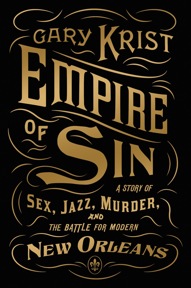An Interview with Gary Krist (Guest Contributor)
Wo nders and Marvels: You began your career writing novels and short stories. What inspired you to start writing about history in the form of narrative nonfiction?
nders and Marvels: You began your career writing novels and short stories. What inspired you to start writing about history in the form of narrative nonfiction?
Gary Krist: Until I hit forty, I read–and wrote–mostly fiction. But at a certain point, I found I wanted to know more about how the world actually came to be, so I started reading history. And that interest soon bled over into my writing life. I began writing a historical novel, Extravagance, which took place partly in late-17th century London. I made several trips to the UK and discovered that I just loved the whole research process. So, after Extravagance, I decided to take the full leap to narrative history, and that’s where I’ve been for my last three books. I do think that I’ll write another novel at some point, but right now I feel I’ve found my true calling.
W&M: As an accomplished writer of fiction, how do you incorporate the art of storytelling when writing history?
Gary Krist: I want my readers to experience history with great immediacy, so I try to alternate background analysis with a series of unfolding foreground episodes that readers can really see and feel, as they would the episodes of a novel. But since I try to hold myself to strict standards of scholarship, I don’t have the freedom to invent dialogue or do extensive imaginary scene-setting. I’ve got to find all of that detail in the historical record. So I’m always on the lookout for things like memoirs, letters, court testimony, and newspaper interviews that can provide the specifics I need. Of course, such sources, like any others, are not necessarily gospel truth, so I have to weigh the reliability of every document. Sometimes I discuss this evaluation process in the endnotes, so readers can see how I make those decisions.
W&M: Does your writing process differ when writing fiction versus narrative nonfiction? How so?
Gary Krist: I always feel that I’m in the narrative business, whether I’m writing fiction or history. And the basics of creating an effective narrative are the same either way. You want to bring out the individuality and motivations of your characters; you want to ground those characters in a world with a vivid texture of sights, sounds, and atmosphere; and you want the action to unfold in a way that keeps readers engaged. But with narrative history, you have to do all of that with the elements of the actual historical record. It can be a challenge.
W&M: What advice do you have for writers who want to take a different approach to writing history?
Gary Krist: Narrative nonfiction history—the kind that aims at a popular audience but maintains high scholarly standards—is still a relatively new genre, so it’s important that writers make clear that they’re not doing New Journalism (with its freely fictionalized elements) or old-style “local-color” history (which dealt in unfootnoted folklore more than verifiable fact). Earning and keeping the trust of your audience is crucial to the success of any piece of narrative nonfiction; readers have to be convinced that what you’ve written is indeed what it purports to be—i.e., NONfiction. That’s why I labor over my endnotes. As a reader, I don’t like sketchy notes that just list a bunch of citations for an entire paragraph, without specifying what fact or quotation came from which source. So as a writer I try to pinpoint exactly where I found a particular detail. I also try to make my notes somewhat conversational, discussing, for instance, the pros and cons of various biographies of a particular figure in the story. “Transparency” is an overused buzzword these days, but I do think it’s something for any writer of nonfiction to strive for.
 Gary Krist is the bestselling author of City of Scoundrels and The White Cascade, as well as several works of fiction. His new book, Empire of Sin: A Story of Sex, Jazz, Murder, and the Battle for Modern New Orleans, has just been published.
Gary Krist is the bestselling author of City of Scoundrels and The White Cascade, as well as several works of fiction. His new book, Empire of Sin: A Story of Sex, Jazz, Murder, and the Battle for Modern New Orleans, has just been published.

